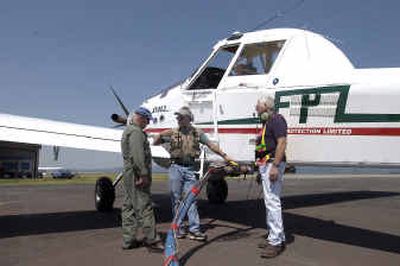Tankers get summer jobs

A pop to the nose can sometimes sting worse than a powerful wallop to the jaw. North Idaho forestry officials hope the same principle holds true when it comes to fighting a fire from the sky. Because large air tankers have been grounded nationwide, there’s no longer one stationed at the Coeur d’Alene Airport during fire season. But the Idaho Department of Lands recently secured the use of three smaller aerial tankers from the Canadian province of New Brunswick. The Air Tractor-802f planes landed in Coeur d’Alene on Tuesday night. Their Canadian pilots spent Friday afternoon flying the region to familiarize themselves with the forests they have been assigned to protect. Each plane carries 800 gallons of retardant. Combined, this is about the same as a large air tanker. The single-engine Air Tractors are capable of flying lower and slower than the large air tankers, said Bob Burke, fire and fuels program manager for the Department of Lands. That makes them more accurate and potentially more effective at stopping fires. The pilots will be stationed at the airport and the planes will be able to lift off within minutes after being called. Three helicopters also will be stationed in Coeur d’Alene during the summer. “Our intent here is to hit every fire very quickly, very hard,” Burke said. “They’re the best opportunity we have.” Citing concerns over airworthiness, the federal government canceled contracts for 33 heavy air tankers in May. After further review, the government expects to allow eight of the planes to return to duty for the fire season, said Bernie Lionberger, aviation officer for the Idaho Panhandle National Forests. “They’ll go where the fires go,” he said. The Air Tractors will be stationed in Coeur d’Alene for at least two months at a cost $3,400 a day a plane, plus $600 an hour during flight. The state will pick up most of the tab, but the Forest Service also will pay for their use when fires are burning on federal land. The price tag might sound steep, Burke said, but not in comparison to the cost of all the firefighters and resources needed to fight a large wildfire. Last year, taxpayers spent roughly $4.5 million fighting a 3,600-acre wildfire near Bonners Ferry. That’s enough money to hire three single-engine air tankers for the next seven summers. “If we can prevent one large fire, then we’ve paid for our fleet,” Burke said. Two other single-engine air tankers will be stationed in McCall, Idaho. Two more will be based in Grangeville. The three planes in Coeur d’Alene will cover forest fires from the Canadian border down to the Clearwater River. They also will help, when needed, on fires in Eastern Washington and Montana. Satellite bases are being set up for the planes at airports in Sandpoint, St. Maries and Shoshone County. Eric Bradley, chief pilot for the Coeur d’Alene squadron, said the Texas-built Air Tractors are ideal firefighting machines. They cruise at around 175 mph, have air-conditioned cockpits and give pilots unrivaled views of the forest below. The pilots are able to drop precise doses of fire retardant. In burning grasslands, the dump can be wide and dispersed. In thick forests, it is heavy and concentrated to penetrate the tree canopy. The planes are not meant to douse the fire, Bradley said. They’re meant to slow its advance, like an aerial bulldozer line. “With early detection and quick response, we’ll catch them before they become national news the next night,” said Bradley, a resident of New Brunswick. Still, the muscle power of firefighters remains the best way of stopping a fire’s advance, said Bud McConnaughey, with the Idaho Panhandle National Forest. “It always takes our forces on the ground to put a fire out,” he said, while standing on the tarmac near the plane. “With these, you’re only buying time.”